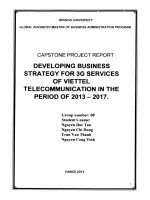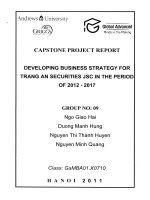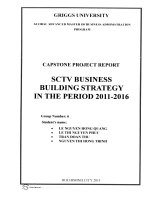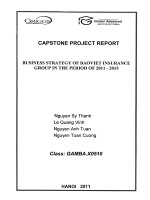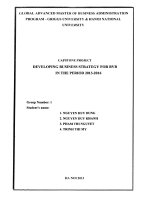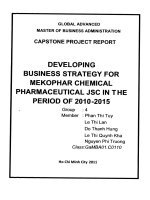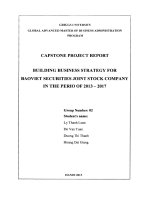Quality assessment the air environment in thai nguyen city in the period of 2016 2018
Bạn đang xem bản rút gọn của tài liệu. Xem và tải ngay bản đầy đủ của tài liệu tại đây (916.96 KB, 76 trang )
THAI NGUYEN UNIVERSITY
UNIVERSITY OF AGRICULTURAL AND FORESTRY
TRAN THI DIEU LINH
QUALITY ASSESSMENT OF THE AIR ENVIRONMENT IN
THAI NGUYEN CITY IN THE PERIOD OF 2016 - 2018
BACHELOR THESIS
Study Mode: Full-time
Major
: Environmental Science and Management
Faculty
: International Program Office
Batch
: 2015 – 2019
Thai Nguyen, 09/2019
DOCUMENTATION PAGE WITH ABSTRACT
Thai Nguyen University of Agriculture and Forestry
Degree Program
Bachelor of Environmental Science and Management
Student name
Tran Thi Dieu Linh
Student ID
DTN1554290039
Quality assessment the air environment in Thai Nguyen
Thesis Title
city in the period of 2016 - 2018
Supervisor (s)
Assoc. Prof. Dr Tran Quoc Hung
Supervisor’s signature
Abstract:
Thai Nguyen city is a metrocity, a political, economic, cultural,
educational, scientific, technical, medical, tourism and service center of Thai
Nguyen province. In recent years, along with the development of society,
activities to build the infrastructure of residential areas, traffic, trade centers,
hotels along with the number of motor vehicles above the city area also
increased significantly, causing great pressure on air pollution. In general, the
air environment in Thai Nguyen city has not been much polluted, toxic gases
such as CO, SO2, NO2 all have concentrations within the permitted standard
limits. However, in industrial production areas, business and service
establishments, on roads and surrounding residential areas, dust pollution, dust
concentration exceeds the permissible standards.
Keywords
Air pollution, Thai Nguyen City, solution, management
Number of pages
75
Date of submission 25/09/2019
i
ACKNOWLEDGEMENT
After a period of studying at Thai Nguyen University of Agriculture and
forestry, I have equipped myself with basically professional knowledge. As the
consensus of the university, the dean committee of the International Training and
Development Center Office and the direct instruction of Assoc.Prof. Dr. Tran
Quoc Hung, I conduct my bachelor thesis: " Quality assessment the air
environment in Thai Nguyen city in the period of 2016 - 2018.”
With deep respect and gratitude, I am extremely grateful to my supervisor
Assoc.Prof. Dr. Tran Quoc Hung for his invaluable useful advice, discussions,
and comments which brought an added value to this research work.
Besides, I would like to thank you for Thai Nguyen center natural resouce
and environment of monitoring facilitating me to finish the investigation.
I sincerely thank the Headmaster, International Training and Development
Center Office and all teachers of Thai Nguyen University of Agriculture and
Forestry for enthusiastically teaching and imparting valuable knowledge to me,
creating good conditions to help me during my studies at the university.
Finally, I would like to express my gratitude to my family, relatives, and
friends who have cared, supported and encouraged me during the process of
studying, researching as well as completing this thesis.
Due to limited professional qualifications, my thesis may be inevitable
shortcomings. I would like to receive the assistance of whole teachers to my
thesis to become better.
Sincerely yours,
Thai Nguyen, September, 2019
Author
Tran Thi Dieu Linh
ii
TABLE OF CONTENT
DOCUMENTATION PAGE WITH ABSTRACT ............................................... i
ACKNOWLEDGEMENT ..................................................................................... ii
TABLE OF CONTENT .............................................................................. iii
LIST OF FIGURES ................................................................................................................. 1
LIST OF TABLES................................................................................................................... 2
LIST OF ABBREVIATIONS .............................................................................................. 4
PART I. INTRODUCTION ............................................................................................... 5
1.1. Research rationale ........................................................................................... 5
1.2. Research’s objectives ...................................................................................... 6
1.2.1. Aims of study ............................................................................................... 6
1.2.2. Significance of study .................................................................................... 6
1.3. Research questions and hypotheses ................................................................. 7
1.4. Limitations ....................................................................................................... 7
1.5. Definitions ....................................................................................................... 8
PART II. LITERATURE REVIEW ............................................................................... 9
2.1. Theoretical base ............................................................................................... 9
2.1.1. Air pollution sources .................................................................................... 9
2.1.2. The harmful effects of air pollution............................................................ 10
2.2. The legal basis ............................................................................................... 13
2.3. An overview of the domestic and foreign research situation. ....................... 13
2.3.1. Research situation over the world .............................................................. 13
2.3.2. The research situation in Vietnam .............................................................. 15
iii
PART III. METHODS ....................................................................................................... 20
3.1. Material .......................................................................................................... 20
3.2. Research contents .......................................................................................... 20
3.3. Methods ......................................................................................................... 20
3.3.1. Methods of collecting secondary data ........................................................ 20
3.3.2. Methods of field survey .............................................................................. 20
3.3.3. Methods of investigation and interview with people ................................. 20
3.3.4. Methods of sampling, analysis and comparison, evaluation with standards.
.............................................................................................................................. 21
3.3.5. Statistic and data processing methods ........................................................ 22
PART IV. RESULTS .......................................................................................................... 23
4.1 . Natural, economic and social conditions of Thai Nguyen City ................... 23
4.1.1. Natural condition ........................................................................................ 23
4.1.2. Economic and social conditions ................................................................. 24
4.1.3. A general assessment of natural and social conditions affecting air quality
in Thai Nguyen City ............................................................................................. 28
4.2. Assessing the air quality environment in thai nguyen city in the period of
2016 – 2018 .......................................................................................................... 30
4.2.1. Sources of pollution .................................................................................... 30
4.2.2. Assessing the air quality environment in thai nguyen city in the period of
2016 – 2018 .......................................................................................................... 33
4.3. Opinions of resident ...................................................................................... 55
PART V. DISCUSSION AND CONCLUSION ........................................................ 62
5.1. Discussion ...................................................................................................... 62
5.1.1. What is current situation of air in Thai Nguyen City? ............................... 62
iv
5.1.2. What are possible management and technology solutions to reduce air
pollution in Thai Nguyen City? ............................................................................ 63
5.2. Conclusion ..................................................................................................... 64
REFERENCES ..................................................................................................................... 66
QUESTIONNAIRE ............................................................................................................. 68
v
LIST OF FIGURES
Figure 2.1: Chart illustrates average years of PM10 at automatic monitoring
stations .............................................................................................. 16
Figure 2.2: Chart describes average years of PM2.5 at automatic monitoring
stations .............................................................................................. 17
Figure 2.3: Chart describes TSP concentration at some streets in the period of
2005-2009 ......................................................................................... 17
Figure 2.4: Chart describes NO2 concentration in the period of 2005-2009 ........ 18
Figure 2.5: Chart describes SO2 concentration in the period of 2005-2009 ........ 19
Figure 4.1: Changes of TSP concentration in the air in Thai Nguyen city area in
2016-2018 ......................................................................................... 37
Figure 4.2: Changes of NO2 concentration in the air in Thai Nguyen city area in
2016-2018 ......................................................................................... 43
Figure 4.3: Changes of CO concentration in the air in Thai Nguyen city area in
2016-2018 ......................................................................................... 48
Figure 4.4: Changes of SO2 concentration in the air in Thai Nguyen city area in
2016-2018 ......................................................................................... 53
1
LIST OF TABLES
Table 3.1: Field sampling methods and laboratory analysis ................................ 21
Table 4.1: Statistics of total pollutant load on all routes from the transport in
2017................................................................................................... 31
Table 4.2: Statistics of total dust released from construction activities in Thai
Nguyen city ....................................................................................... 32
Table 4.3: Locations of air environment monitoring points in Thai Nguyen city
according to the provincial environmental monitoring network ...... 33
Table 4.4: Environmental monitoring results for TSP in Thai Nguyen city in the
period of 2016 ................................................................................... 34
Table 4.5: Environmental monitoring results for TSP in Thai Nguyen city in the
period of 2017 ................................................................................... 35
Table 4.6: Environmental monitoring results for TSP in Thai Nguyen city in the
period of 2018 ................................................................................... 36
Table 4.7: Environmental monitoring results for TSP in Thai Nguyen city in the
period of 2016-2018.......................................................................... 37
Table 4.8: Environmental monitoring results for NO2 in Thai Nguyen city in the
period of 2016 ................................................................................... 40
Table 4.9: Environmental monitoring results for NO2 in Thai Nguyen city in the
period of 2017 ................................................................................... 41
Table 4.10: Environmental monitoring results for NO2 in Thai Nguyen city in the
period of 2018 ................................................................................... 42
Table 4.11: Environmental monitoring results for NO2 in Thai Nguyen city in the
period of 2016-2018.......................................................................... 43
2
Table 4.12: Environmental monitoring results for CO in Thai Nguyen city in the
period of 2016 ................................................................................... 45
Table 4.13: Environmental monitoring results for CO in Thai Nguyen city in the
period of 2017 ................................................................................... 46
Table 4.14: Environmental monitoring results for CO in Thai Nguyen city in the
period of 2018 ................................................................................... 47
Table 4.15: Environmental monitoring results for CO in Thai Nguyen city in the
period of 2016-2018.......................................................................... 48
Table 4.16: Environmental monitoring results for SO2 in Thai Nguyen city in the
period of 2016 ................................................................................... 50
Table 4.17: Environmental monitoring results for SO2 in Thai Nguyen city in the
period of 2017 ................................................................................... 51
Table 4.18: Environmental monitoring results for SO2 in Thai Nguyen city in the
period of 2018 ................................................................................... 52
Table 4.19: Environmental monitoring results for SO2 in Thai Nguyen city in the
period of 2016-2018.......................................................................... 53
Table 4.20: Statistics of interviewing residents in 6 monitoring environment
locations ............................................................................................ 56
3
LIST OF ABBREVIATIONS
API
: Air Pollution Index
BTNMT
: Natural resources and environment ministry
QCVN
: National technical regulations on environment
TSP
: Total suspended dust
WHO
: World Heath Organazition
4
PART I. INTRODUCTION
1.1. Research rationale
Thai Nguyen city is a metrocity, a political, economic, cultural, educational,
scientific, technical, medical, tourism and service center of Thai Nguyen province,
80km far from Hanoi. The total natural area is 177km2, the North borders Dong Hy
district and Phu Luong district, the East borders Song Cong town, the West
borders Dai Tu district, the South borders Pho Yen district and Phu Binh district.
Over the past years, along with the general development of the province, Thai
Nguyen city has also achieved great socio-economic achievements, industrial,
agricultural and forestry production value in the locality.
Thai Nguyen City is home to most factories, enterprises, industrial zones
such as Gang Thep Thai Nguyen Complex, Cao Ngan Thermal Power Plant, and
Luu Xa and Quan Trieu Cement Plant. This is an important factor to promote the
socio-economic development of the city, but it is also the factor that causes the
problems of the living environment, especially the air environment.
In the city, the number of production and business establishments
generating emissions in the production process is quite large. These include units
capable of generating toxic emissions such as SO2 and heavy metal dust (color
metallurgy plants), silicon dust (cement plants) and dangerous organic
compounds. The facilities are mostly located in densely populated areas, densely
populated and the fact that units with exhaust treatment systems are few or
ineffective and the operation of dust treatment systems, emissions are not high.
In recent years, along with the development of society, activities to build
the infrastructure of residential areas, traffic, trade centers, hotels along with the
5
number of motor vehicles above the city area also increased significantly,
causing great pressure on air pollution.
In general, dust and emissions causing air pollution in Thai Nguyen city
area has caused great impacts on the urban landscape and people's life in the
city area.
The assessment of the current status of environmental quality,
understanding the causes of pollution as well as proposing to develop specific
measures to control and minimize air pollution for Thai Nguyen city area is
very urgent.
For these reasons, I selected the topic "Quality assessment the air
environment in Thai Nguyen city in the period of 2016 - 2018" to assess the
current status quality of air environment, identify the causes polluting the air
environment, on that basis, proposed and developed specific solutions to control
and reduce air pollution in Thai Nguyen city area.
1.2. Research’s objectives
1.2.1. Aims of study
- Assessing the air quality status in Thai Nguyen City in the period of
2016 - 2018
- Provide solutions to minimize air pollution in Thai Nguyen city
1.2.2. Significance of study
a. Significance in studies and science researchers
Through the implementation of the study, students become familiar with
the scientific research, strengthen their knowledge, apply theory to practice,
understand how to collect, analyze and process information and work skills
6
b. Significance in life
Air pollution is the pressing problem in the world in generally and our
country in particularly. So the management air quality must be conducted tightly
in order to reduce emissions into the environment. Periodic monitoring air of the
city contributes greatly to the environmental management of the city and the
competent authorities in the detection parameters exceed permissible emissions
standards for reasonable prevention measures timely.
The study assesses the air quality of the city exactly, is the base of the
environmental protected evaluation of the city. Researching results is the basis
for the selection of measures to reduce emissions in the city, facilitate sustainable
development.
1.3. Research questions and hypotheses
- Is there air pollution in Thai Nguyen City in period 2016 – 2018?
- Can we apply some management and techonology solutions to reduce
air pollution in Thai Nguyen City?
1.4. Limitations
Thesis was conducted during 4 months from March 2019 to July 2019.
When researching and reporting on air pollution, there were many limitations to
the author due to:
- The educational level of the author is not sufficiently specialized in
the issue of air pollution.
- The funding is not large, so it is not possible to use specialized
machines.
- Operating time and funds are not sufficient for large-scale research.
7
1.5. Definitions
Air pollution is the introduction of particulates, biological molecules, or
other harmful materials into Earth's atmosphere, causing disease, death to
humans, damage to other living organisms such as food crops, or the natural or
built environment. Air pollution may come from anthropogenic or natural
sources. (Josie,2015)
Particulate Matter (PM) is the term for a mixture of solid particles and
liquid drops found in the air. Some common particles such as dust, dirt, soot,
smoke are easily detected by the naked eye, but of which there are too small
particles
that
can
only
be
detected
through
electron
microscopy.
(McCracken,2016)
Total suspended dust (TSP) is the total of aerodynamic particles less than
or equal to 100 μm.
8
PART II. LITERATURE REVIEW
2.1. Theoretical base
2.1.1. Air pollution sources
There are many sources of air pollution. It can be divided into natural
sources and artificial sources.
Natural sources:
+ Wind pollution: Wind is also one of the causes of air pollution. Dirt,
gases that can be pushed away by the wind for hundreds of kilometers make the
contamination spread to a large extent quickly. (Thu,2019)
+ Storm: Generating NOx is the main cause of the storm becoming a
cause in the process of causing environmental pollution. Besides sandstorm
carrying fine dust (PM10, PM2.5) makes the rate of fine dust pollution increases.
(Thu,2019)
+ Forest fires: Forest fires will increase the amount of nitrous oxide in the
air because of the large scale of the fire and a long time of extinguishing.
(Thu,2019)
+ Volcano: When there is a volcanic eruption, an amount of gas.
(Thu,2019)
Artificial sources:
In addition to natural factors, humans are the main cause of air pollution.
Human activities such as living, production, construction, and transportation
have an increasingly affect the air environment, making pollution more and more
serious and urgent. Here are some of the causes of air pollution under the
influence of people:
9
+ Smoke, dust from factories: Occupying the largest proportion of the
causes of air pollution not only but also water and food sources. In the smoke
from factories, there is a large amount of CO2, CO, SO2, NOx, unburnt organic
substances: soot, dust, and so on with extremely high concentrations. If in the
process of handling bad emissions, it will adversely affect the health of people
living in that area. This is also the main cause of acid rain causing a lot of
damage to people as well as crops. (Thu,2019)
+ Traffic: The amount of smoke and dust from cars, motorbikes, vehicles
in general using gas fuel to operate ... is also very large because the number of
people participating in daily traffic is extremely high. For countries that are either
underdeveloped or developing, vehicles may cause more air pollution when using
outdated vehicles as well as unreliable public transport infrastructure. (Thu,2019)
+ Besides, war or military exercises: nuclear weapons, poison gas,
chemical warfare and missiles are also one of the causes of this air pollution.
(Thu,2019)
2.1.2. The harmful effects of air pollution
a. For animals – plants:
+ Air pollution causes harmful effects to all organisms. (Nam,2017)
+ Sulfur dioxide, nitrogen dioxide, ozone, fluorine, lead ... directly harm
plants when entering stomata, damaging the system to reduce drainage and
reduce disease resistance. (Nam,2017)
+ Earth's warming due to the greenhouse effect also causes changes in
plants and animals on Earth. (Nam,2017)
10
+ Acid rain also indirectly affects plants and lacks food like Ca and kills
soil microorganisms. It causes Al ion to be released into the water to damage the
roots (absorbing feathers) and reduce the absorption of food and water.
(Nam,2017)
+ For animals, especially pets, fluoride causes more disasters. They are
poisoned by direct inhalation and through the food chain. (Nam,2017)
+ Acidic air pollutants will combine with water droplets in the cloud to
make the water acidic. When the water drops on the ground, it will harm the
environment: killing trees, animals, fish, etc. Acidic water also changes the
nature of water in rivers, streams, etc harming the living things underwater.
(Nam,2017)
b. For human:
Dust:
+ Harmful effects of dust depend on nature (composition) of dust, dust
concentration, dust particle size, contact time and personal response.
(Phuong,2016)
+ Dust into the lungs causes mechanical irritation, pulmonary fibrosis
leading to respiratory diseases. (Phuong,2016)
+ Dust can cause eye, skin and blood sugar diseases and other body
systems (Dust enters the body and dissolves in blood and body fluids),
cardiovascular disease ...
+ Dust can cause cancer: dust containing toxic ingredients, asbestos dust ...
Dioxide Sulfur (SO2) and Nitrogen Dioxide (NO2):
Sulfur Dioxide (SO2).
11
+ Sulfur Dioxide is a gas formed by oxidation of sulfur (S) when burning
fuels such as coal, oil, products of oil, sulfide ore, etc. SO2 is a gas that causes
strong respiratory irritation when breathing SO2 gas (even at low concentrations)
can cause spasm of the bronchial straight muscles. Large concentrations of SO2
can cause increased mucus secretion in the upper respiratory tract mucosa and
bronchial air branches. SO2 affects the function of the lungs, causing pneumonia,
chronic bronchitis, causing cardiovascular disease, hypersensitivity in people
with asthma. (Phuong,2016)
+ SO2 poisoning through the skin reduces alkaline reserves in the blood,
eliminates ammonia to the urine and releases saliva. (Phuong,2016)
+ General toxicity of SO2 expressed in disorders of protein and sugar
metabolism, lack of vitamins B and C, inhibition of oxidase enzymes.
Nitrogen Dioxide (NO2):
+
Nitrogen Dioxide (NO2): is a brown gas, produced by Nitrogen
oxidation at high temperature. NO2 is a dangerous gas, has a strong effect on
respiratory organs especially in susceptible groups such as children, the elderly,
asthma sufferers. –If contact with NO2 will damage the lung mucosa, increase the
risk of respiratory diseases, damage of lung, eye, nose, and throat functions, etc.
(Phuong,2016)
Carbon monoxide (CO)
+ Carbon monoxide (CO) combined with hemoglobin (Hb) in the blood
to be a stable compound, carboxyhemoglobin (HbCO), reduces blood oxygen
transport capacity, leading to a lack of oxygen in the blood. (Phuong, 2016)
Ammonia (NH3)
12
+ NH3 is a toxic gas that can strongly stimulate the nose, mouth and
respiratory system.
+ Exposure to NH3 at a concentration of 100mg / m3 in a short period of
time will not have long-term consequences, but if exposed to NH3 at a
concentration of 1500-2000 mg / m3 for 30 minutes, it will be dangerous to live.
(Phuong,2016)
2.2. The legal basis
- Environmental Protection Law of Vietnam No. 55/2014 / QH13 dated
23/06/2014
- Circular No.28 / 2011 / TT-BTNMT 01/08/2011 of Ministry of Natural
Resources and Environmental regulated technical processes of environmental
monitoring ambient air and noise.
- Circular No.21 / 2012 / TT-BTNMT dated 12/19/2012 Regulations on
quality assurance and quality control in environmental monitoring.
- National technical regulations on environment.
- QCVN 05:2013/BTNMT: National Technical Regulations on Ambient
Air Quality.
- QCVN 06:2009/BTNMT: National technical regulations on some toxic
substances in the ambient environment.
- QCVN 26:2010/BTNMT: National technical regulations on noise.
2.3. An overview of the domestic and foreign research situation.
2.3.1. Research situation over the world
In new estimates free, WHO reports that in 2012 around seven million
people died - one in eight of total world deaths as a result of pollution exposure.
13
This finding quite doubles previous estimates and confirms that air pollution is
presently the world's largest single environmental health risk. Reducing pollution
might save many lives. (Anilla Cherian, 2015)
In 2012, Italy had the best range of premature deaths within the EU28 due
to gas and dioxide exposure. Nearly half of London's most disadvantaged
neighborhoods exceeded EU dioxide (NO2) limits in 2017 compared with two of
its wealthiest areas. Heart-attack survivors exposed to semipermanent pollution
within the London space were a lot of probably to be readmitted to the hospital,
wherever they conjointly had higher mortality rates. Similar findings were
according to France, Germany, Malta, The Netherlands, Wales, and Wallonia,
per data-mining analysis from the EU atmosphere Agency. (Kosovo, 2018).
In a recent announcement by Chinese officials, Beijing is being placed in
the level of red alert on air pollution, perhaps even a large-scale air pollution
crisis. In November 2015, the World Health Organization (WHO) said that the
level of smoke in China was 50 times higher than the organization's safety
recommendation. A number will certainly startle more people about the level of
pollution in China, which is 4,000 people die every day due to pollution in China.
Beijing has also closed many factories, schools, limited construction works and
many other recreational activities from December 8-10, 2015. Although Beijing
has experienced a lot of terrible pollution, this is the first time the Chinese capital
has issued such a high-level ban. (WHO, 2015)
The level of air pollution in Hong Kong has risen to a record high, with
the Environmental Protection Agency warning of the "toxic smoke" covering the
city as a threat to the people. The Hong Kong government has said that the
14
current air pollution index (API) has doubled and people are advised to stay
indoors or avoid long-term exposure to heavy traffic areas. "The a is currently at
the highest record" the Environmental Protection Agency spokesman said: Hong
Kong's famous horizon are often covered in mist and dust, which is a disaster for
the health of the people and leaves some people away from this international
financial center. Based on the API index, people with cardiovascular and
respiratory problems are advised to stay indoors, when the index drops to more
than 100. The public is advised to stay indoors, avoiding long-term exposure to a
large area of vehicles, area with API index more than 200. (Ernest Kao, 2018).
Few people know that India's New Delhi Capital is the most polluted city
in the world, with the proportion of deaths due to air pollution only after
cardiovascular disease. Serious air pollution is caused mainly by vehicle
emissions, with an estimated 8.5 million vehicles operating here. Recently the
Institute of Energy Resources New Delhi and the Institute of Health Impact
(USA) have published research showing that every year 3,000 people die in New
Delhi because of air pollution.
The World Health Organization (WHO) said Doha is now one of the cities
with the highest levels of air pollution in the world. In a recent report, the government
said the cause of serious pollution in the country was due to the booming construction
industry as well as the rising emissions of vehicles. (WHO, 2015).
2.3.2. The research situation in Vietnam
In Vietnam, air pollution is an urgent problem for urban, industrial and craft
villages. Air pollution not only negatively affects human health. The stronger the
industrialization, the more waste sources will pollute the air environment. In the
15
development process, especially in the past decade, big cities like Hanoi, Ho Chi
Minh City has encountered serious air pollution problems caused by industrial,
agricultural, transportation and living activities. Air environment in urban areas in
Vietnam is influenced by many sources of waste (Ha, 2018).
The northern cities of Vietnam all have high average annual dust
concentrations. Hanoi is the city with the highest level of dust pollution (the annual
average value of PM10 and PM2.5 in the period of 2010-2018 fluctuates in the
range of 46.2 - 100.8 µg / m3 respectively and 35.5 - 59.4 µg / m3). Urban areas in
the Central Region - South Central Coast have lower levels of dust pollution than
Northern cities. Hue city, located in central Vietnam, near the sea but still
influenced by a part of the Northern monsoon climate, has an average annual
concentration of PM10 and PM2.5, which is approximately the norm, from 38.4 to
41 , 7 µg / m3 and 22.1 - 24.5 µg / m3 in the years from 2013 -2015. (Nam, 2018).
Figure 2.1: Chart illustrates average years of PM10 at automatic
monitoring stations
16
Figure 2.2: Chart describes average years of PM2.5 at automatic monitoring
stations
Pollution for total suspended dust (TSP) is serious, especially pollution
along the main roads of the city.
(Source: Regional stations & regional development (Land 1, 2, 3) - 2010)
Figure 2.3: Chart describes TSP concentration at some streets in the period
of 2005-2009
The CO, SO2, NO2 in the air in urban areas are generally still within the
permitted threshold. However, in some locations and in some times,
concentrations of these substances have increased, in some cases exceeding the
permitted values. Due to the impact of traffic activities, the concentration of NO2
17
is near. the roads are higher than other areas. Especially in urban areas with high
traffic density like TP. Ho Chi Minh City, the concentration of NO2 in the air is
much higher than other cities. This proves that NO2 is generated mainly from
traffic activities in the city (Phong, 2019).
(Source: Regional stations & regional development (Land 1, 2, 3) - 2010)
Figure 2.4: Chart describes NO2 concentration in the period of 2005-2009
The annual average concentration of SO 2 and CO in areas in the city is
still within the permitted limits of QCVN 05: 2013 / BTNMT. Since the
majority of SO2 arises from industrial production activities, the difference in
concentration of SO2 between residential areas and roads is not much and
tends to decrease because part of the production facilities are relocated,which
out of cities in recent years.
18
Figure 2.5: Chart describes SO2 concentration in the period of 2005-2009
(Source: QT & PT station of mainland 1; institute of environmental
science and technology - university of civil engineering, 2009)
19
